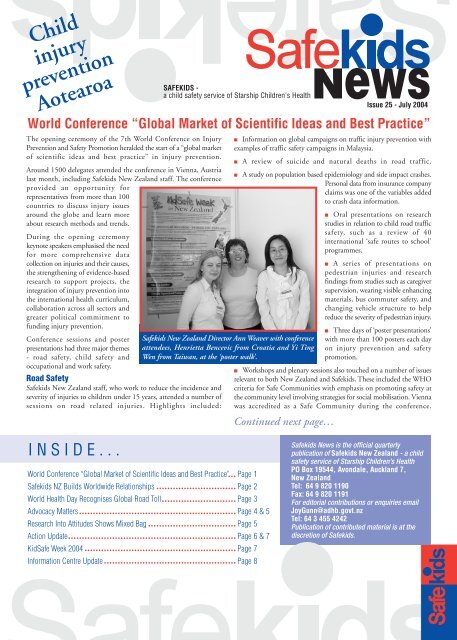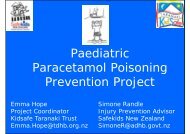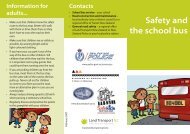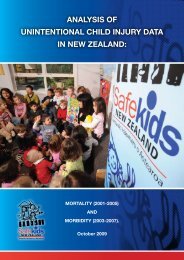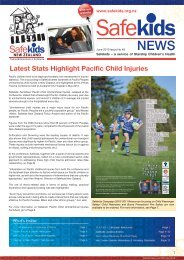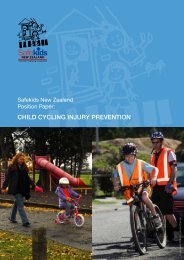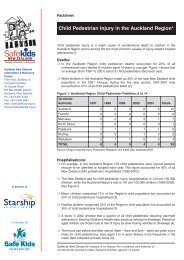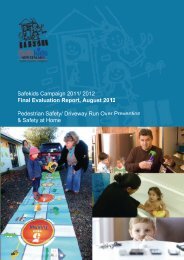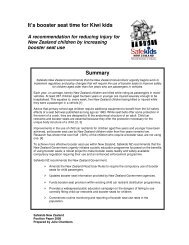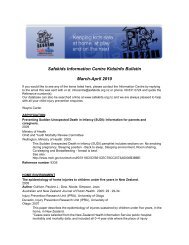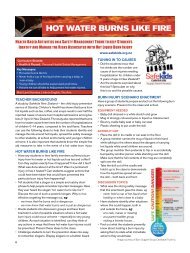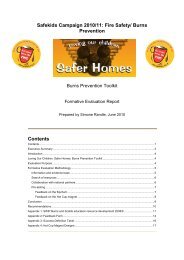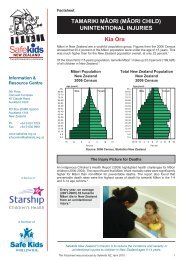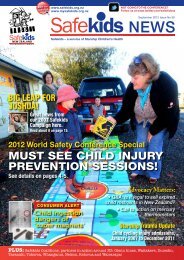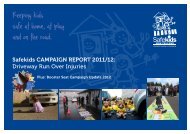Issue 25, July 2004 - Safekids
Issue 25, July 2004 - Safekids
Issue 25, July 2004 - Safekids
Create successful ePaper yourself
Turn your PDF publications into a flip-book with our unique Google optimized e-Paper software.
Child<br />
injury<br />
prevention<br />
Aotearoa<br />
World Conference “Global Market of Scientific Ideas and Best Practice”<br />
The opening ceremony of the 7th World Conference on Injury<br />
Prevention and Safety Promotion heralded the start of a “global market<br />
of scientific ideas and best practice” in injury prevention.<br />
Around 1500 delegates attended the conference in Vienna, Austria<br />
last month, including <strong>Safekids</strong> New Zealand staff. The conference<br />
provided an opportunity for<br />
representatives from more than 100<br />
countries to discuss injury issues<br />
around the globe and learn more<br />
about research methods and trends.<br />
During the opening ceremony<br />
keynote speakers emphasised the need<br />
for more comprehensive data<br />
collection on injuries and their causes,<br />
the strengthening of evidence-based<br />
research to support projects, the<br />
integration of injury prevention into<br />
the international health curriculum,<br />
collaboration across all sectors and<br />
greater political commitment to<br />
funding injury prevention.<br />
Conference sessions and poster<br />
presentations had three major themes<br />
- road safety, child safety and<br />
occupational and work safety.<br />
Road Safety<br />
<strong>Safekids</strong> New Zealand staff, who work to reduce the incidence and<br />
severity of injuries to children under 15 years, attended a number of<br />
sessions on road related injuries. Highlights included:<br />
I N S I D E . . .<br />
SAFEKIDS -<br />
a child safety service of Starship Children's Health<br />
<strong>Safekids</strong> New Zealand Director Ann Weaver with conference<br />
attendees, Henrietta Bencevic from Croatia and Yi Ting<br />
Wen from Taiwan, at the ‘poster walk’.<br />
World Conference “Global Market of Scientific Ideas and Best Practice” ●●●Page<br />
1<br />
<strong>Safekids</strong> NZ Builds Worldwide Relationships ●●●●●●●●●●●●●●●●●●●●●●●●●●●●●Page<br />
2<br />
World Health Day Recognises Global Road Toll ●●●●●●●●●●●●●●●●●●●●●●●●●●●Page<br />
3<br />
Advocacy Matters ●●●●●●●●●●●●●●●●●●●●●●●●●●●●●●●●●●●●●●●●●●●●●●●●●●●●●●●●●Page<br />
4 & 5<br />
Research Into Attitudes Shows Mixed Bag ●●●●●●●●●●●●●●●●●●●●●●●●●●●●●●●●Page<br />
5<br />
Action Update ●●●●●●●●●●●●●●●●●●●●●●●●●●●●●●●●●●●●●●●●●●●●●●●●●●●●●●●●●●●●●Page<br />
6 & 7<br />
KidSafe Week <strong>2004</strong> ●●●●●●●●●●●●●●●●●●●●●●●●●●●●●●●●●●●●●●●●●●●●●●●●●●●●●●●Page<br />
7<br />
Information Centre Update ●●●●●●●●●●●●●●●●●●●●●●●●●●●●●●●●●●●●●●●●●●●●●●●●Page<br />
8<br />
<strong>Issue</strong> <strong>25</strong> - <strong>July</strong> <strong>2004</strong><br />
■ Information on global campaigns on traffic injury prevention with<br />
examples of traffic safety campaigns in Malaysia.<br />
■ A review of suicide and natural deaths in road traffic.<br />
■ A study on population based epidemiology and side impact crashes.<br />
Personal data from insurance company<br />
claims was one of the variables added<br />
to crash data information.<br />
■ Oral presentations on research<br />
studies in relation to child road traffic<br />
safety, such as a review of 40<br />
international ‘safe routes to school’<br />
programmes.<br />
■ A series of presentations on<br />
pedestrian injuries and research<br />
findings from studies such as caregiver<br />
supervision, wearing visible enhancing<br />
materials, bus commuter safety, and<br />
changing vehicle structure to help<br />
reduce the severity of pedestrian injury.<br />
■ Three days of ‘poster presentations’<br />
with more than 100 posters each day<br />
on injury prevention and safety<br />
promotion.<br />
■ Workshops and plenary sessions also touched on a number of issues<br />
relevant to both New Zealand and <strong>Safekids</strong>. These included the WHO<br />
criteria for Safe Communities with emphasis on promoting safety at<br />
the community level involving strategies for social mobilisation. Vienna<br />
was accredited as a Safe Community during the conference.<br />
Continued next page…<br />
<strong>Safekids</strong> News is the official quarterly<br />
publication of <strong>Safekids</strong> New Zealand - a child<br />
safety service of Starship Children’s Health<br />
PO Box 19544, Avondale, Auckland 7,<br />
New Zealand<br />
Tel: 64 9 820 1190<br />
Fax: 64 9 820 1191<br />
For editorial contributions or enquiries email<br />
JoyGunn@adhb.govt.nz<br />
Tel: 64 3 455 4242<br />
Publication of contributed material is at the<br />
discretion of <strong>Safekids</strong>.
continued from previous page<br />
Capacity Building<br />
Capacity building was also of interest to <strong>Safekids</strong><br />
New Zealand representatives who attended sessions<br />
looking at various injury prevention training facilities<br />
around the globe. Oral presentations were held on<br />
cross-sectoral injury prevention strategies, with<br />
examples such as supporting health promotion<br />
through injury prevention training for polytech<br />
students; the development of a safety strategy for<br />
the Aboriginal community in NSW; the<br />
development of a new degree course integrating<br />
wellness, health promotion and injury prevention;<br />
and developing competencies for injury prevention<br />
training.<br />
Education<br />
During the conference a number of presentations<br />
were held on injury prevention education from<br />
around the world. Programmes presented included<br />
a safety education classroom on wheels – similar<br />
to the “Life Education Trust” vehicles in NZ, an<br />
interactive computer game for adolescents based<br />
on the use of alcohol and situated in an emergency<br />
department in USA, and an interactive computer<br />
flash game for families in China on home safety.<br />
Evaluation<br />
Evaluation of interventions was discussed at the<br />
conference, with a number of examples provided<br />
by speakers from various countries – including a<br />
volunteer-based home visit programme, the<br />
effectiveness of health education interventions on<br />
unintentional suffocation and drowning to children<br />
aged 0-4 in rural China, and a safety education<br />
programme in the United Kingdom.<br />
A series of oral sessions on community programmes<br />
and cost / benefit evaluations covered a number of<br />
topics. Among these were studies which had been<br />
used to investigate stakeholder perceptions on an<br />
injury issue; development of an integrated approach<br />
among stakeholders; a range of projects involving<br />
the 3Es (Engineering, Education and Enforcement)<br />
in enhancing traffic safety; managing road safety<br />
problems with regard to border crossings in central<br />
Europe; a mobile photo radar programme; and a<br />
pre-school children’s traffic club education project.<br />
New Zealand had a definite presence at the<br />
conference with Kiwis presenting their work in a<br />
range of areas. Papers were presented by<br />
representatives from Auckland University, the Otago<br />
University Injury Prevention Research Unit, the<br />
Land Transport Safety Authority and Waitakere<br />
City.<br />
<strong>Safekids</strong> New Zealand was one of the participants<br />
in a ‘poster walk’ for delegates – demonstrating the<br />
Spectrum of Prevention model it uses for its<br />
programme development and work.<br />
For copies of all conference abstracts visit<br />
www.safety<strong>2004</strong>.info/final_programme.php<br />
SAFEKIDS NZ BUILDS<br />
WORLDWIDE RELATIONSHIPS<br />
SAFE KIDS China displays its work<br />
through the photo exhibition<br />
organised by SAFE KIDS Worldwide.<br />
Part of New Zealand’s contribution<br />
to the SAFE KIDS Worldwide photo<br />
exhibition at Vienna.<br />
2<br />
The 7th World Conference on Injury<br />
Prevention held in Vienna provided<br />
an opportunity for SAFE KIDS<br />
Worldwide member countries,<br />
including New Zealand, to meet. High<br />
on the list of discussion topics for the<br />
group were the common challenges<br />
and successes shared when supporting<br />
communities and delivering child<br />
injury prevention programmes.<br />
SAFE KIDS Worldwide<br />
representatives from such diverse<br />
locations as China, Australia, USA,<br />
Israel, Brazil, Austria, Vietnam, South<br />
Korea, and the Philippines, used the<br />
World Conference on Injury<br />
Prevention to further the Worldwide<br />
organisation’s goals of strengthening<br />
relationships, building new friendships<br />
and providing opportunities for<br />
member countries to learn about the<br />
many and varied programmes<br />
undertaken to keep children injury<br />
free across the world.<br />
A highlight of the group’s time in<br />
Vienna was a photo exhibition of<br />
SAFE KIDS’ activities around the<br />
world in a glittering Vienna City Hall<br />
Gallery. The exhibit was sponsored<br />
by Safe Kids Austina, SAFE KIDS<br />
Worldwide and Johnson & Johnson.<br />
<strong>Safekids</strong> New Zealand was proud to<br />
contribute to the poster exhibition<br />
with photographs showing the use of<br />
safety gates and fireguards to keep<br />
children safe in the home.<br />
SAFE KIDS Worldwide members from around the globe made the most of<br />
Vienna to share information.
WORLD HEALTH DAY RECOGNISES GLOBAL ROAD TOLL<br />
Children in Auckland City ‘played dead’ on the road as they portrayed<br />
the grisly results of road related injuries and deaths. In other parts<br />
of the country young drivers were targeted with safety messages and<br />
New Zealand media were inundated with press statements about<br />
what we, as a nation need to do to achieve a lower road toll.<br />
All this activity and more was undertaken to promote the World<br />
Health Organisation (WHO) Day on April 7 which focused on<br />
Road Safety. The event marked the first time that the organisation<br />
had targeted such an issue – and the milestone was commemorated<br />
across the world.<br />
The organisation’s goal was to raise awareness of the health impact<br />
and social and economic costs of road traffic injuries, to highlight<br />
vulnerabilities of certain groups of road users, and call for action to<br />
increase efforts to prevent road traffic injuries.<br />
And, this goal was achieved, not only here but globally. On May<br />
22, the World Health Assembly and General Assembly unanimously<br />
adopted Resolution WHA 57.10 on Road Safety – a direct result<br />
of WHO Day. This Resolution accepted the invitation of WHO to<br />
act as a co-ordinator in the UN system in collaboration with regional<br />
It’s a fact! 1<br />
■ It’s estimated that road crashes killed around 1.18 million people<br />
worldwide in 2002, and injured about 20 to 50 million more.<br />
■ By the year 2020, if current trends continue, road traffic injuries<br />
will have risen by more than 60%, making them the third leading<br />
contributor to the global burden of disease and injury worldwide.<br />
■ Every day around 140,000 people are injured on the world’s roads.<br />
More than 3,000 die, and some 15,000 are disabled for life.<br />
■ Some 50% of road traffic fatalities worldwide involve young adults<br />
aged 15-44 years – the most economically productive segment<br />
of the population (the NZ figure is even higher, at 58%).<br />
■ For adult men aged 15-44 years, traffic injuries rank second to<br />
HIV/AIDS as the leading cause of ill health and premature death<br />
worldwide (in NZ they rank second behind suicide).<br />
■ Globally, according to conservative estimates, the annual costs of<br />
road traffic injuries amount to approximately NZ$769 billion.<br />
■ By 2020, if current trends continue, the annual numbers of road<br />
traffic deaths and disabilities in high-income countries may have<br />
decreased by as much as 30%. However, this gain could be<br />
cancelled out by a 60% increase in road traffic deaths in low<br />
income countries.<br />
The New Zealand story 2<br />
■ Since the first known fatal crash in Christchurch in 1908, more<br />
than 34,000 people have lost their lives on our roads. The<br />
deadliest year on our roads was 1973, when 843 people<br />
were killed.<br />
■ In the last 20 years, the social cost of crashes totalled $85<br />
billion (June 2002 prices). Social costs are all costs that<br />
are inflicted on the community – its material loss, pain,<br />
suffering and the costs to emergency services and other<br />
health providers.<br />
■ In 2003 there were 460 deaths and around 14,000 injuries.<br />
Drink-driving contributed to 30% and excessive speed to<br />
35% of fatal crashes in 2003. Nearly 27% of the vehicle<br />
occupants killed last year were not wearing safety belts.<br />
■ If there were no future road safety interventions and the current<br />
trends continued, by 2020 New Zealand’s yearly road toll could<br />
be as high as 780 deaths and 24,000 reported injuries.<br />
New Zealand has given road deaths a shot in the arm 2<br />
■ New Zealand’s road fatality rate has come down by 37 percent<br />
since 1990, in spite of significant increases in population, vehicles<br />
and kilometres driven.<br />
3<br />
commissions. It urged member states to appoint focal points in<br />
ministries of health to co-ordinate a public health response to road<br />
traffic death and injury. It called for member states to undertake a<br />
number of activities to reduce road deaths – including assessment<br />
of national situations, preparation of national strategies, and<br />
establishment of government leadership through a primary lead<br />
agency and exploration of possible increased funding for strategies.<br />
A full copy of the Resolution can be accessed at<br />
http://www.who.intgb/ebwhapdf_files/WHA57/A57_R10-eng.pdf<br />
In New Zealand, road traffic deaths were likened to an epidemic –<br />
one that this country was giving a shot in the arm to with injury<br />
prevention, education and enforcement programmes.<br />
Both historically and currently these include police speed campaigns,<br />
Land Transport Safety Authority advertising and education strategies,<br />
driver education schemes, community road safety interventions and<br />
a central government commitment to cyclists and pedestrians.<br />
<strong>Safekids</strong> New Zealand supported WHO Day with a joint reminder<br />
along with Plunket, for caregivers to ensure children are buckled up<br />
each and every time they travel in a vehicle.<br />
■ If education, enforcement and engineering measures had not been<br />
introduced, and if fatality rates remained at 1990 levels, growth in<br />
the vehicle fleet would have pushed annual deaths up from 729 in<br />
1990 to an estimated 900 in 2002.<br />
■ In 1997 NZ ranked 16th out of 28 OECD countries for deaths per<br />
10,000 vehicles. We currently rank 11th - equal with Italy and<br />
Finland and ahead of the United States, Ireland and Denmark.<br />
1 Statistics supplied by the World Health Organisation<br />
2 Statistics supplied by the Land Transport Safety Authority
ADVOCACY MATTERS<br />
Housing New Zealand<br />
Corporation Walks the Talk<br />
In 1996 <strong>Safekids</strong> New Zealand prepared a report, Safe As<br />
Houses – Recommendations for Childsafe Housing New<br />
Zealand Homes, which provided New Zealand’s largest<br />
rental agency, Housing New Zealand, with recommendations<br />
about ways it could improve the safety of its homes for<br />
residents under 15 years. This month Housing New Zealand’s<br />
General Manager, Assets and Development Services, Greg<br />
Orchard, reports on Housing New Zealand’s progress in<br />
helping keep Kiwi kids ‘safe as houses’. He pays particular<br />
attention to the steps undertaken to prevent burns to children<br />
– an issue for <strong>Safekids</strong> in <strong>2004</strong>.<br />
Over the last three years, Housing New Zealand Corporation (HNZC)<br />
has continued to improve child safety within our homes. This has<br />
been achieved by aligning our acquisition and design criteria with<br />
recommendations made in Safe as Houses? – Recommendations for<br />
Childsafe Housing New Zealand Homes.<br />
Opportunities for identifying and addressing potential injury hazards<br />
have also arisen through HNZC’s Healthy Housing, Modernisation<br />
and Energy Efficiency Retrofit programmes.<br />
Improvements continue to be made as part of ongoing maintenance<br />
and replacement activities.<br />
Reflecting on KidSafe Week’s burns focus, here are some examples of<br />
what HNZC has done over the past three years to make homes safer<br />
for children:<br />
■ Safe hot water delivery - HNZC has installed 4990 hot water<br />
tempering valves.<br />
■ Smoke detectors - HNZC has installed over 145,000 smoke detectors,<br />
both new and replacements.<br />
■ Smoke detectors are checked and tested every six months. If<br />
faulty, they are generally repaired/replaced either immediately or<br />
within 24 hours.<br />
■ Over <strong>25</strong>,000 properties have had the alarms cleaned and tested<br />
in addition to the six monthly tests.<br />
■ Between 1996 - when the <strong>Safekids</strong> report was received - and<br />
2000, HNZC installed smoke detectors in all properties.<br />
■ Hardwired alarms - A further 1092 permanently wired detectors to<br />
HNZC properties have been installed.<br />
■ Safe stoves - HNZC has installed approximately 6,435 anti-tip<br />
brackets on stoves. The Corporation has also asked Electrolux to<br />
design and manufacture a stronger bracket. This is scheduled to be<br />
in use from <strong>July</strong> <strong>2004</strong>.<br />
■ HNZC Housing Specification – the following requirements help<br />
prevent scalding and burns by being included in the HNZC Housing<br />
Specification:<br />
■ in houses with hot water tempering devices the hot water<br />
temperature is set at a maximum 55 degrees at any hot water<br />
outlet in the bathroom and shower<br />
■ new stoves are installed with anti-tipping devices<br />
■ fixed-fan electric heaters are installed in some living spaces.<br />
4<br />
Additional child safety features:<br />
■ Safe glazing - HNZC has replaced 3,798 windows with safety glass<br />
in 3,527 houses.<br />
■ Fall-safe windows - HNZC has installed 110,946 security stays in<br />
21,093 houses.<br />
The Development Guide - Ensuring future HNZC homes are child safe<br />
This document advocates well considered design that makes housing<br />
safe and healthy for children, for example:<br />
■ private outdoor spaces that have secure boundaries for children’s<br />
play areas<br />
■ a preference for separate showers and baths - curved baths are<br />
dangerous for standing<br />
■ kitchens off the circulation path<br />
■ child safety locks on laundry/bathroom cupboards<br />
■ sufficient power sockets to reduce use of extension cords<br />
■ specified lighting levels, particularly for kitchens, bathrooms<br />
and other task areas.<br />
While the Guide is not new it emphasises principles of good design<br />
for ongoing reference.<br />
More positive changes to enhance health and safety in HNZC homes:<br />
■ Interior painting - HNZC has changed its interior painting specification<br />
to remove most volatile solvents from the paint used for all<br />
decoration. In addition, the requirement for turpentine and other<br />
poisonous/flammable solvents on-site is reduced to a very low<br />
level. Use of acrylic paints will reduce the amount of volatile organic<br />
compounds released inside HNZC properties by about 121,000<br />
litres over three years. This will help children and others living in<br />
newly painted houses to breathe without inhaling solvents emitted<br />
by enamel paints. Those suffering from asthma will find this reduces<br />
their symptoms.<br />
■ Mould - All repainted ceilings will now use Mouldshield, an acrylic<br />
paint expected to significantly reduce the incidence of mould on<br />
ceilings. Mould can aggravate some respiratory complaints.<br />
HNZC continues to “walk the talk” in child safety, by providing and<br />
taking opportunities to improve health and safety within our homes.<br />
Part of this commitment to children is in their continued working<br />
relationship with <strong>Safekids</strong> New Zealand.<br />
<strong>Safekids</strong> Applauds<br />
Canadian Baby Walker Ban<br />
In March, Canada became the first country to ban the<br />
importation, advertising and sale of babywalkers – a move<br />
<strong>Safekids</strong> New Zealand applauds wholeheartedly.<br />
Since 2000, <strong>Safekids</strong> New Zealand has been attempting to<br />
ban babywalkers in New Zealand – but has only been successful<br />
in obtaining a voluntary standard for manufacturers and<br />
importers. While this has gone some way to a long-term<br />
reduction in babywalker related injuries to children, <strong>Safekids</strong><br />
believes that the ban by Canada is a much more significant<br />
and lasting solution. <strong>Safekids</strong> is pleased with the move by the<br />
Canadian government and is hopeful that, in time, babywalkers<br />
will be banned in other countries around the world, including<br />
New Zealand.
New Playground Equipment Standard Announced<br />
After more than four years of discussion and<br />
submissions, New Zealand’s new playground<br />
equipment standard, NZS 5828:<strong>2004</strong><br />
Playground equipment and surfacing, was<br />
released in May this year. The new standard<br />
affects all playground equipment built,<br />
imported and used in New Zealand. NZS<br />
5828:<strong>2004</strong> will replace the previous standard<br />
published in 1986 one year from its release.<br />
Standards New Zealand project manager<br />
Beatrice Dias-Wanigasekera says the new<br />
standard is thought to be the best outcome<br />
in terms of challenge and development for<br />
New Zealand children and their safety.<br />
That sentiment is shared by Professor David<br />
Chalmers of the University of Otago Injury<br />
Prevention Research Unit (IPRU), who<br />
believes that while the injury prevention<br />
community did not ‘win’ in all areas when it<br />
came to the new standard, it provides the best<br />
Recent research undertaken by BRC<br />
Marketing and Social Research into attitudes<br />
to child safety show New Zealanders have<br />
mixed opinions when it comes to supervision<br />
and protection of children.<br />
The research, conducted in consultation with<br />
<strong>Safekids</strong> New Zealand in March of this year,<br />
found New Zealanders were split down the<br />
middle when it came to the question of<br />
whether we over-protect our children.<br />
Those surveyed were asked whether they agreed<br />
that New Zealand parents over-supervise<br />
children, thus hampering a child’s ability to<br />
learn how to be safe. While 43% of those<br />
questioned agreed with the statement, another<br />
43% disagreed. Nearly half of the respondents<br />
living in rural areas disagreed that we overprotect<br />
children.<br />
compromise for all those<br />
involved.<br />
The new standard is based<br />
on European standards<br />
which have been adopted<br />
instead of American<br />
standards, felt by the<br />
standards committee to be<br />
too restrictive.<br />
“Playground users will notice<br />
a number of changes, specific<br />
to New Zealand. For<br />
example the fall height of<br />
upper body equipment has<br />
been reduced from 2.5 metres to 2.2 metres.<br />
There has also been a relaxing of the restrictions<br />
on the equipment for supervised early<br />
childhood play centres,” said Ms Dias-<br />
Wanigasekera.<br />
Professor Chalmers was particularly pleased<br />
by the lowering of the fall height of swings<br />
and climbing equipment for these settings to<br />
1.5m from 1.8m.<br />
Other criteria which affect early childhood<br />
education settings include:<br />
■ Any climbing equipment over 600mm must<br />
be on an approved impact attenuation<br />
surface (soft fall). This is a change from<br />
the present 500mm height.<br />
■ The soft surface must extend 1.5m all<br />
around the equipment (this is reduced from<br />
the current 1.9m)<br />
■ Movable equipment such as climbing boxes<br />
and similar can be up to 1.2m maximum<br />
<strong>Safekids</strong>’ Director, Ann Weaver, says the research<br />
company was asked to put these types of<br />
questions to the public to “find out what people<br />
really think – not just what a few media reports<br />
say.”<br />
The research was undertaken following media<br />
reports that New Zealanders molly-coddled<br />
children, and <strong>Safekids</strong> wanted to gauge the<br />
public’s opinion on this issue.<br />
The research provided some interesting points<br />
in terms of perception about injury and injury<br />
prevention.<br />
“As unintentional injury is the leading cause of<br />
death for children from 1 – 14 years, in this<br />
country we were keen to find out what people’s<br />
understanding was about the issues, whether<br />
they felt they had a role to play in preventing<br />
injury and what they were aware of when it<br />
came to safety.”<br />
5<br />
height and other equipment such as an<br />
overhead ladder or connection bridge can<br />
be up to 1.5m<br />
■ There can be more than two swings per<br />
bay in a swing structure. (The standard for<br />
public playgrounds is limited to 2 swings<br />
per bay) provided other associated safety<br />
requirements are met.<br />
■ Static climbing structures must have a<br />
guard rail across all openings, including<br />
slides<br />
“One of the most positive things is that we<br />
actually have a standard after almost 15 years…<br />
and the standard is a good standard,” states<br />
professor Chalmers.<br />
Around one quarter of all fall injuries to<br />
children aged under 15 years are playground<br />
related, and over the years the number of<br />
children injured while using playground<br />
equipment has increased. He attributes this<br />
to a number of things - more equipment being<br />
available for children, and more exposure to<br />
that equipment, but doubts we will see either<br />
a decrease or an increase in the number of fall<br />
injuries to children in the short term with the<br />
introduction of the new standard. What he<br />
is hopeful of, he says, is that playground related<br />
fall injuries will plateau in the short term.<br />
Standards New Zealand plans to promote the<br />
new standard, which is voluntary, in a bid to<br />
ensure as many stakeholders as possible are<br />
aware of the new regulations and to ensure<br />
their implementation on a wide basis. Dr<br />
Dias-Wanigasekera said they may hold<br />
promotional seminars on the standard next<br />
year.<br />
RESEARCH INTO ATTITUDES SHOWS MIXED BAG<br />
The research found that 64% of those surveyed<br />
believed children were more at risk from<br />
unintentional injury than intentional injury<br />
such as assault. Sixty percent believed that<br />
adults played a role in preventing injuries to<br />
children – with 71% of those in households<br />
with children under five years believing that<br />
prevention was possible.<br />
“That people understand prevention is possible<br />
– and that we, as adults play a huge role in this,<br />
is encouraging,” Ms Weaver said.<br />
“The opportunity to work with BRC Marketing<br />
& Social Research and to obtain this kind of<br />
information has been of great benefit to us, as<br />
it provides us with a much clearer picture of<br />
what people know and understand.”<br />
For more information about this research please<br />
contact Ann Weaver, Director, <strong>Safekids</strong> on<br />
09-820 1194 or email AnnWeaver@adhb.govt.nz
ACTION UPDATE<br />
Regional Action: “Vision Zero” for Auckland Road Safety<br />
On April 6 the Auckland Regional Road Safety<br />
Plan <strong>2004</strong> to 2010 was launched by Auckland<br />
Regional Council and RoadSafe Auckland. The<br />
plan, launched to contribute to global activity<br />
for WHO Day on April 7, outlined a range of<br />
strategies to reduce the region’s road toll by<br />
embracing a ‘vision zero’ and safety management<br />
systems approach.<br />
Road safety agencies in the region state they<br />
have adopted a long-term ‘vision zero’ approach<br />
to road safety, with the aim being that no road<br />
users are killed or seriously injured on<br />
Auckland’s roads. Improved co-ordination of<br />
roading, community development, education<br />
and enforcement efforts form part of the plan,<br />
together with actions that draw on best-practice<br />
from other countries.<br />
It is a decade since RoadSafe Auckland launched<br />
its first regional plan, and since that time<br />
significant progress has been made to improve<br />
the safety of road users. Today, approximately<br />
20% fewer people are killed in road crashes in<br />
the Auckland Region than in 1994. More<br />
people wear safety belts and fewer people drink<br />
and drive.<br />
The new regional plan outlines the road safety<br />
challenges for the Auckland Region and signals<br />
a continuing need for agencies and the<br />
Communities in Action:<br />
Safe Community Celebration for Waitakere<br />
Chart topping singer/songwriter Che Fu (pictured) joined participants<br />
and supporters of the Safe Communities movement to celebrate<br />
Waitakere City’s fifth anniversary as a WHO Safe Community.<br />
Che sang about safety as hundreds of guests celebrated the milestone<br />
with a City Safe Picnic. Lunch, entertainment and safety messages<br />
delivered by artists and musicians were all part of the day. During<br />
the event Safe Waitakere Injury Prevention (SWIP) board members,<br />
including <strong>Safekids</strong> Director Ann Weaver, signed a Safe Community<br />
Agreement, recommitting to make Waitakere City a safe community<br />
through implementation of a long term injury control programme.<br />
community to work together to bring about<br />
further change. The plan contains five broad<br />
goals that relate to the leading crash factors<br />
within the region. In summary these goals aim<br />
to:<br />
1. Reduce alcohol related crashes<br />
2. Reduce speed related crashes<br />
3. Reduce intersection crashes<br />
4. Reduce the number of pedestrians killed<br />
and injured<br />
5. Increase the level of occupants using<br />
restraints.<br />
Regional Manager for the Land Transport<br />
Safety Authority (LTSA), Peter Kippenberger,<br />
welcomed the plan.<br />
“More people die on the roads in the Auckland<br />
Region than any other region in New Zealand,<br />
accounting for over 20 per cent of all road<br />
deaths. Auckland region’s unique transport<br />
challenges mean that a planned and coordinated<br />
approach to road safety is more<br />
important than ever and the Regional Road<br />
Safety Plan provides a way forward.”<br />
To download a copy of the Regional<br />
Road Safety Plan <strong>2004</strong> to 2010 in pdf<br />
format visit either www.arc.govt.nz or<br />
www.roadsafeauckland.org.nz<br />
6<br />
To highlight the number of children<br />
injured or killed on the Auckland region’s<br />
roads, 90 children presented a dramatic<br />
performance on Auckland’s Queen St.<br />
Performed to sound effects and music,<br />
the children lay down on the road and<br />
51 of their body shapes were traced<br />
around with white chalk to represent the<br />
51 child deaths that have occurred over<br />
the last five years on the roads. A small<br />
white bouquet of flowers was left on each<br />
shape and 51 crosses placed on a large<br />
board.<br />
.............................................<br />
Communities Living Injury Free in Auckland City<br />
Last month Auckland City launched Communities Living Injury<br />
Free, a programme to reduce the number and severity of injuries for<br />
city residents from Otahuhu to Avondale and the eastern suburbs.<br />
The launch introduced the Communities Living Injury Free<br />
programme’s new logo, website and branding, while delivering some<br />
serious injury prevention messages in a light hearted and fun way.<br />
The Communities Living Injury Free programme is funded by the<br />
Ministry of Health and administered by Auckland City Council’s<br />
Community Development Division. More than a hundred members<br />
of the community, including representatives from organisations such<br />
as <strong>Safekids</strong>, the Child Safety Foundation, ACC, Plunket, Watersafe<br />
Auckland, Age Concern, Alcohol Healthwatch, the NZ Police, NZ<br />
Fire Service, and Housing New Zealand, attended the celebration.<br />
Representatives from Primary Health Organisations, the Auckland<br />
District Health Board, local Maori and Pacific Island health providers<br />
and new settler groups were also there, as were key researchers and<br />
academics specialising in this area<br />
For more information about the programme, you can check<br />
out the Communities Living Injury Free website at<br />
www.aucklandcity.govt.nz/injuryfree
Bath Time<br />
Safety Campaign<br />
Bath toys make a splash with the<br />
Auckland injury prevention community<br />
– and hopefully caregivers. Photo courtesy<br />
of the Whangarei Leader.<br />
KidSafe Week Information and Planning days,<br />
held in 16 centres during April and May,<br />
brought more than 280 representatives<br />
together from a wide range of organisations<br />
for a focus on child safety.<br />
The Information and Planning Days focused<br />
on providing information about the causes of<br />
injury, and activities and issues for <strong>2004</strong>.<br />
Prevention of burn injuries and motor vehicle<br />
passenger injuries are the themes for<br />
communities this year and representatives<br />
from the Fire Service, Public Health, Plunket,<br />
the NZ Police, ACC, Land Transport Safety<br />
Authority, local councils, and the education<br />
sector, took the opportunity to brainstorm<br />
ideas for local activity.<br />
Suggested activities varied around the country,<br />
depending on current work being carried out,<br />
and issues for communities. However, a<br />
number of activities were put forward by<br />
communities including:<br />
■ Holding of free child restraint check clinics<br />
using Safe2Go technicians to check restraints<br />
■ Training of coalition members as Safe2Go<br />
trainers<br />
■ Checkpoints by police and coalitions during<br />
October and throughout the year<br />
A campaign to reduce the high drowning rate among one-year-olds has begun on Auckland’s<br />
North Shore and in Whangaparoa.<br />
ShoreSafe Children, WaterSafe Auckland and Plunket are working together to promote bath<br />
time safety messages for the parents of toddlers. Every child attending their nine-month Well<br />
Child Check with Plunket or other health providers will be given bath toys during the<br />
campaign. The toys come in the form of four colourful foam bath stickers – each a different<br />
water animal.<br />
Each bath sticker carries a safety message:<br />
- Always stay with us at bath time - Run cold water first<br />
- Always use a non-slip bath mat - Always put the plug up high<br />
Caregivers will be provided with brochures containing suggestions for water play and water<br />
safety appropriate to the age group targeted, e.g. bubble games to play in the bath and paddling<br />
pool activities designed to introduce water to young children in an enjoyable and safe<br />
environment.<br />
The Bath Time Safety Project is based on an idea developed by the Northland Community<br />
Injury Prevention Group. The project targets nine-month-old babies as Coronial data from<br />
January 1999 – <strong>July</strong> 2002 showed 40% of children who drowned were aged one year.<br />
By getting in early with safety messages, the project team hope to raise awareness among<br />
parents whose children are about to reach the danger age. The team hope to extend the project<br />
region-wide. WaterSafe Auckland is seeking funding for the project to be carried out in<br />
Waitakere City as statistics show that drowning, burns, and falls, feature highly in the child<br />
mortality rate for the Waitakere area.<br />
The Papakura Kidsafe Coalition has received some funding through an ACC Child Safety<br />
Grant to distribute these resources as part of their activities for KidSafe Week <strong>2004</strong>.<br />
For information about the North Shore campaign, please contact Teresa Stanley,<br />
WaterSafe Auckland, ph 09-306 0809, 027 285 9045, or email<br />
teresa.stanley@watersafe.org.nz.<br />
.............................................<br />
KIDSAFE WEEK <strong>2004</strong><br />
Info Days Bring Communities<br />
Together<br />
In Taranaki local organisers used the<br />
Information & Planning Day as an<br />
opportunity to show their Recognition<br />
Certificate, presented at the KidSafe Week<br />
Leadership Conference in March, for past<br />
KidSafe Week campaigns.<br />
■ Checkpoints and education at sports<br />
registration days<br />
■ Child restraint checks at early childhood<br />
education centres<br />
■ Open days at NZ Fire Service stations<br />
■ Community safety days with emphasis on<br />
burns prevention<br />
■ Campaign to have local coffee shops use<br />
coasters with hot water safety messages<br />
■ Promotion with local Master Plumbers<br />
Association members around hot water and<br />
safety<br />
■ Smoke alarm check campaign<br />
Information was also provided to participants<br />
about next year’s campaign and future plans<br />
for KidSafe Week.<br />
7<br />
FIREMAN ED’S VISIT for Preschoolers<br />
Darfield librarian and local KidSafe Week<br />
coalition co-ordinator, Lynda Seaton, has once<br />
again written a wonderful book for preschool<br />
and young primary school-aged children focused<br />
around one of this year’s themes burns prevention.<br />
Fireman Ed’s Visit provides younger children<br />
with important safety messages about the dangers<br />
of fire and what do in if a fire occurs. Approved<br />
by the New Zealand Fire Service, the book will<br />
be available in the lead up to KidSafe Week (in<br />
both English and Maori) for purchase by<br />
coalitions or educators.<br />
Books cost $6.00 each plus postage and<br />
packaging and can be ordered by phoning<br />
Sandra James on (03) 313 6136 or emailing<br />
sandra@wmk.govt.nz
Info Centre Update from : Simon Whitlock<br />
Below are recent pieces of information from both New Zealand<br />
and overseas which investigate and/or provide safety information<br />
around the issue of child pedestrian injury related to reversing<br />
vehicles and driveways. To order a copy of any of these items please<br />
contact Simon at the <strong>Safekids</strong> Information and Resource Centre<br />
Child deaths and injuries in<br />
driveways: Response to the<br />
recommendations of the child<br />
death review team 2000<br />
Henderson, Michael<br />
Motor Accidents Authority of<br />
NSW<br />
http://www.maa.nsw.gov.au<br />
Record # 50<strong>25</strong><br />
Devices to reduce the risk to<br />
young pedestrians from<br />
reversing motor vehicles 2001<br />
Paine, Michael and Henderson,<br />
Michael<br />
Motor Accidents Authority of<br />
NSW<br />
http://www.maa.nsw.gov.au<br />
Record # 5026<br />
Pedestrian injuries 1999<br />
Hockey, Richard<br />
Queensland Injury Surveillance<br />
Unit (QISU)<br />
Injury Bulletin 52(feb)99 entire<br />
issue<br />
Record # 5172<br />
Injuries in the home: Toddler’s<br />
low speed run overs 1997<br />
Queensland Injury Surveillance<br />
Unit<br />
Injury Bulletin 46(dec)97 1<br />
Record # 5181<br />
Driveway injuries in children:<br />
Risk factors 2001<br />
Nadler, Evan P. et al.<br />
Department of Surgery, Children’s<br />
Hospital of Pittsburgh<br />
Pediatrics 108(2)01 326-328<br />
Record # 5187<br />
Vehicles reversing or rolling<br />
backwards: an underestimated<br />
hazard 2001<br />
Mayr, J.M. et al.<br />
Injury Prevention 7(4)dec01 327-<br />
328<br />
Record # 5413<br />
Outcomes of pediatric<br />
pedestrian injuries by locations<br />
of event 2001<br />
Di Scala, Carla et al.<br />
45th Annual Proceedings:<br />
Association for the Advancement<br />
of Automotive Medicine-<br />
September 24-26, 2001 241-249<br />
Record # 5478<br />
Injuries and deaths among<br />
children left unattended in or<br />
around motor vehicles - United<br />
States, <strong>July</strong> 2000-June 2001<br />
2002<br />
Morbidity and Mortality Weekly<br />
Report (MMWR) 51(26)02 570-<br />
572<br />
Record # 5767<br />
Driveway deaths: Fatalities of<br />
young children in Australia as<br />
a result of low-speed motor<br />
vehicle impacts 2002<br />
Neeman, Terry et al.<br />
Australian Transport Safety Bureau<br />
Road Safety Report CR 208<br />
Record # 5811<br />
Driveway-related motor<br />
vehicle injuries in the<br />
paediatric population: a<br />
preventable tragedy 2002<br />
Murphy, Feilim et al.<br />
The New Zealand Medical Journal<br />
115(1160)02<br />
Record # 5898<br />
Why our children are not as<br />
safe as we think they are 2002<br />
Beasley, Spencer<br />
Department of Paediatric Surgery,<br />
Christchurch Hospital<br />
The New Zealand Medical Journal<br />
115(1160)02<br />
Record # 5899<br />
For more information contact: Simon Whitlock, Information Service Manager, <strong>Safekids</strong> Information and Resource Centre<br />
162 Blockhouse Bay Rd, PO Box 19544, Avondale, Auckland, New Zealand. Ph (09) 820 1193, fax (09) 820 1191<br />
Emails: safekids@iconz.co.nz — simonw@adhb.govt.nz — Internet: www.safekids.org.nz<br />
8<br />
quoting the title and four-digit reference number of the item(s)<br />
you are interested in viewing. A more comprehensive list of all<br />
items held within this topic can be created by visiting our website.<br />
Go to http://www.safekids.org.nz/index.php/pi_pageid/<strong>25</strong> and<br />
type driveways in the keyword box.<br />
Home driveway injuries and<br />
fatalities in the Auckland<br />
region 2002<br />
<strong>Safekids</strong><br />
Auckland Regional Fact Sheet<br />
Record # 6126<br />
Driveway injuries: A<br />
preventable tragedy 2002<br />
<strong>Safekids</strong><br />
<strong>Safekids</strong> News 17(jun)02 1-3<br />
Record # 6218<br />
Driveway accident prevention:<br />
Tips for improving safety while<br />
reversing<br />
NSW Motor Accidents Authority<br />
http://www.maa.nsw.gov.au/roadsa<br />
fety36reports.htm<br />
Record # 6498<br />
Children’s response to a<br />
commercial back-up warning<br />
device 2003<br />
Sapien, R.E. et al.<br />
Injury Prevention 9(1)03 87-88<br />
Record # 6607<br />
Low speed run-overs of young<br />
children in QLD 2003<br />
Hockey, Richard et al.<br />
Queensland Injury Surveillance<br />
Unit (QISU)<br />
Injury Bulletin 76(mar)03 entire<br />
issue<br />
Record # 6622<br />
Car rear vision blind spots<br />
killing children 2002<br />
Tyler, Fran<br />
The Dominion Post (11nov)02<br />
Record # 6705<br />
The danger to young<br />
pedestrians from reversing<br />
motor vehicles<br />
Paine, Michael et al.<br />
Paper No. 466<br />
Record # 6928<br />
Four children crushed in their<br />
driveways 2001<br />
Godbole, P. et al.<br />
Department of Paediatric Surgery,<br />
Leeds Teaching Hospital NHS<br />
Trust, Leeds, UK<br />
Journal of the Royal Society of<br />
Medicine (94)01 294-296<br />
Record # 7223<br />
Preventing home driveway<br />
injuries to our children 2003<br />
Safe Waitakere<br />
This is a colour A4 flyer resource<br />
which provides parents and caregivers<br />
with safety advice around the<br />
prevention of driveway injury to<br />
children. Also see rec # 7264.<br />
Record # 7263<br />
Going out? Where are the kids?<br />
- Ka wehe atu koe i te kainga?<br />
Kei hea ou tamariki? 2003<br />
Safe Waitakere<br />
This bilingual double-sided resource<br />
hangs on the door to the home. It<br />
provides a reminder for parents and<br />
adults to check on the whereabouts<br />
of young children before driving<br />
vehicles off the property to ensure that<br />
they are not run over.<br />
Record # 7264<br />
Safety in driveways: Death of<br />
toddler underlines concerns<br />
2003<br />
Royal New Zealand Plunket<br />
Society Inc.<br />
Plunket Safety Update (spr)03 2<br />
Record # 7292<br />
Vehicle Access: Extract of<br />
section 2.4 from NZS<br />
4102:1996 Safer House Design<br />
1996<br />
Standards New Zealand - Paerewa<br />
Aotearoa<br />
Wellington, Standards New<br />
Zealand: 1996<br />
Extract of section 2.4 from New<br />
Zealand Standard 4102:1996 Safer<br />
House Design which concerns vehicle<br />
access and driveway design.<br />
Record # 7610


